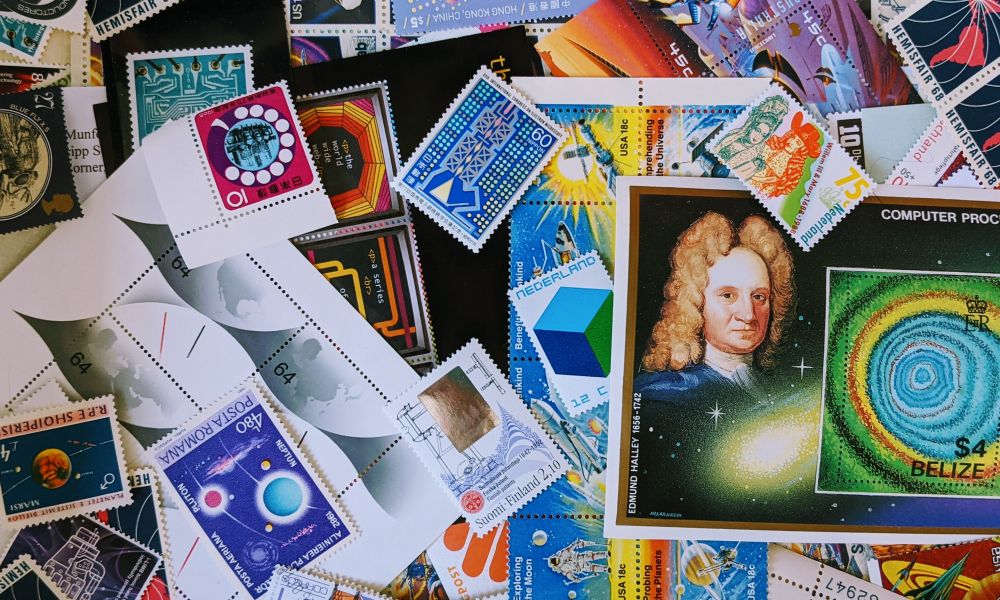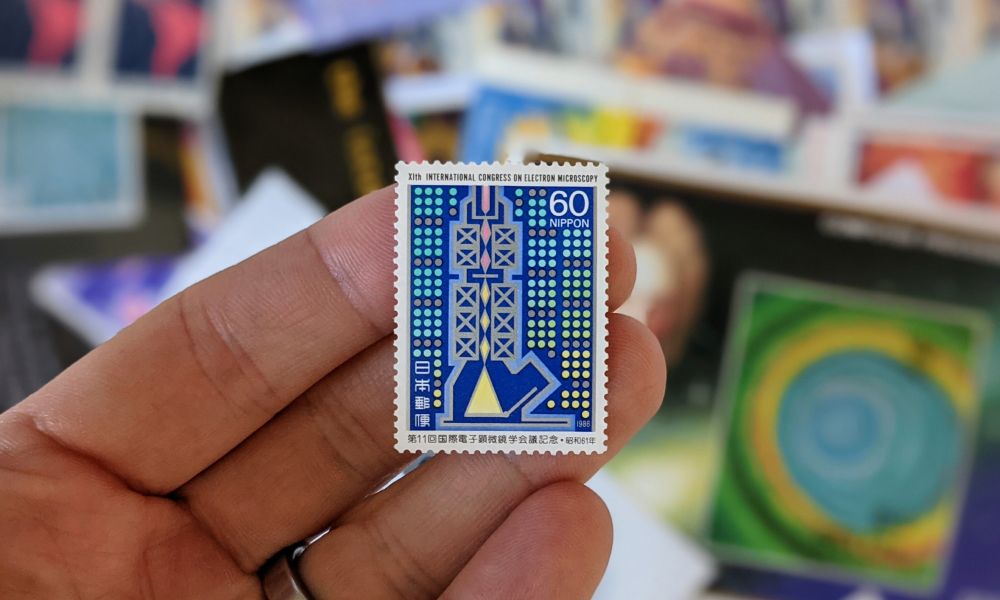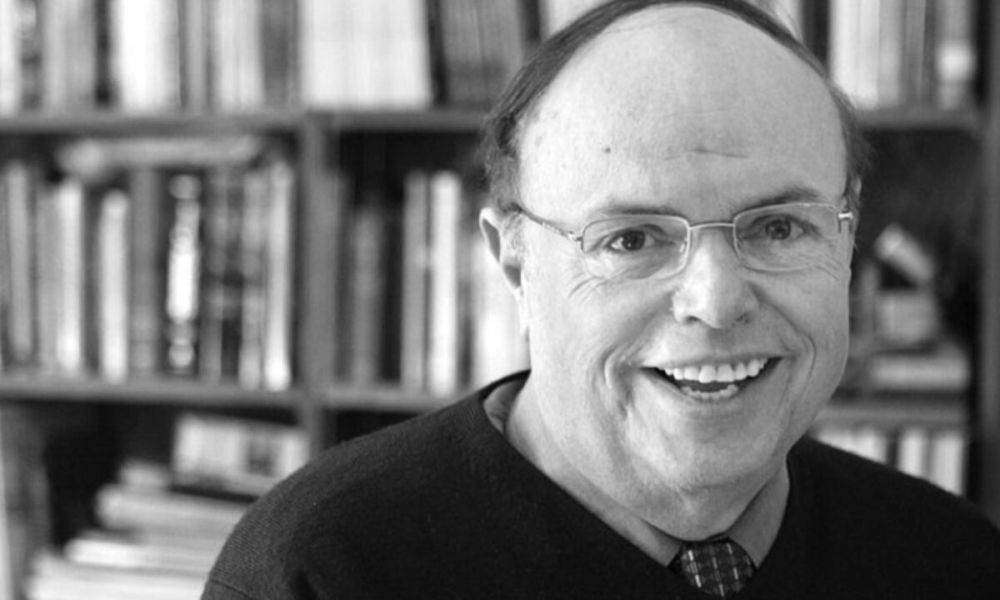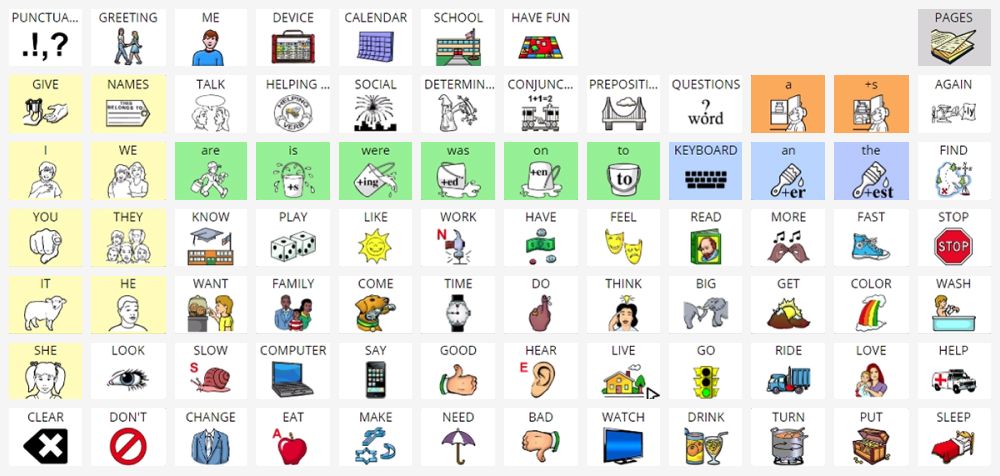Small Images
Stamps, Computational Linguistics, and Minspeak all share a reliance upon the way pictures can communicate faster than words.

Though I am not much of a collector, I have a stamp collection. It’s a pretty modest one, all things considered; I would estimate it at couple hundred stamps in total. True philatelists would be horrified by its current condition. They all live, unsorted, in a single bin with a lid. For what it’s worth, they do stay in pretty good condition in there.
But more importantly, the mixed-up cache of stamps lends itself to exploration. I like to open it up from time to time and find new things. Touching them, flipping them over to uncover their images, feeling the different surfaces, stumbling upon unintended juxtapositions — it’s all part of the experience for me.
My daughter gets as much out of this collection as I do. Over the last year, she has discovered a variety of innovative activities on her own, home-bound as we’ve been. One of them has been pulling out my bin of stamps and taking them out, one by one, and arranging them in ways that make sense to her. While I’m not sure she fully understands the purpose of a stamp — and certainly not the purpose of a stamp collection — there is something about these artifacts that captivates her.
Her four-year-old hands find their size to be just right. The imagery, too, is an obvious draw. The wide variety of bright colors, bold letters, and interesting shapes offers much to catch the eye of a little one. But I am convinced that what fills her with wonder about her stamp sifting ritual is the same for us both: the surprise and serendipity of the experience.
Each time she opens the lid and dumps out the contents of the bin, the experience is different. There are new combinations of images. There are stamps that rise to the top that she hasn’t examined before. I can see on her face that watching the wave of tiny paper squares pour out from the bin, their streams of color new each time, may be the height of excitement in this game, but it’s the incredible focus in the moments afterward which proves where the wonder is for her. It’s in the beauty of the images.
Recently, she and I sat at our dining room table, a newly poured pile of stamps before us. The first stamp she chose to examine was this one. She had no idea how special this particular stamp is.

This Japanese stamp commemorating the International Congress on Electron Microscopy is one of the most important stamps in my collection. Not because of its age, its provenance, or its worth to serious collectors. It’s valuable to me. For one thing, it’s beautiful. It’s an exquisitely designed image that holds my attention. I always find something new to see in it. But more importantly, this one stamp carries a story about a person who was important to me, and even more important to the world.
▣
When I was around 9 years old, my father took me out to lunch in Cambridge, Massachusetts. We had recently moved away and had returned to visit. My father had arranged to meet up with a friend of his, Bruce, and he brought me along.
I remember feeling comfortable with Bruce right away. He had a face that radiated kindness. He smiled widely and his eyes kept smiling even when his mouth did not. As we looked over the menu, Bruce said, “So Chris, what are you interested in?”
I had recently become interested in stamps, and so I said that. To my surprise, Bruce was an avid stamp collector. He was as pleased to talk about stamps as I was.

Bruce and my father had met through their work. My father (pictured above on the left with another colleague, ca. 1984) is a software engineer, and at the time, he worked within a research group that developed augmented communications for the disabled. I assumed Bruce did this kind of thing, too. The conversation drifted from stamps to things that they were eager to catch up on, and I was happy to listen. After about an hour, we’d finished our lunch and parted ways. Bruce waved as he crossed the street and my father and I headed in the opposite direction.
Some weeks later, after we’d returned home from our visit, a large manila envelope was delivered to our house, addressed to me. I opened it eagerly. Inside was a horde of stamps, sent by Bruce! I was thrilled. My collection at the time had been just a handful of stamps; Bruce had single-handedly 10x’ed it.
In the decades since then, many of those stamps have been lost. I probably traded some of them and used others — I have always liked to use old stamps on new letters, just to bring some surprise to whomever is on the other end of the delivery. Some of Bruce’s stamps are likely still in my collection. I have never kept a record of where my stamps came from, so I can’t be sure about most. But there is one stamp I know came from Bruce. I distinctly remember carefully pulling out a beautiful stamp from a wax envelope labeled “Japan” among others in that package that Bruce sent thirty years ago. I looked at it for a long time that day. I also remember looking at it many other times in the years since. Each time, I thought of Bruce. And so when my daughter pulled it out from the pile on our dining room table, I thought of him again.

This is Bruce. After our lunch in 1989, I learned a bit more about him.
Bruce Baker was a linguist. His career had become increasingly technological as he looked for ways to better communicate with people who have disabilities. His research into how interactions between the disabled and the abled worked — and didn’t — led him to an important discovery. In his own words:
“The first few individuals I talked to had difficulty communicating with me, so I tried to construct a coding system to facilitate our information exchange. This led me to an investigation of AAC systems available at the time. I found these systems to be, in my opinion, linguistically primitive. They seemed to take very little advantage of the substantial and growing field of knowledge about linguistics and computational linguistics. I determined to build a system — or to have some role in building a system — that would take advantage of these modern linguistic insights.”
Bruce invented Minspeak in 1980. Minspeak is a computer-driven pictorial language for people who cannot speak. It was, and remains, an incredible achievement.
In addition to its incredible utility — in making it possible to quickly and easily communicate when you are unable to vocalize — Minspeak is a fascinating nexus of ideas. Because it is made up of images, rather than a system of text characters that can be combined to form words, it is a language that carries meaning in a quite different way. Bruce explained it this way:
“As I saw the communication aids that were built in the 1970’s, it became plain to me that none of them seemed to be taking advantage of the possibilities of generating language for people with disabilities by using any of the artificial intelligence techniques that were being developed for language translation. The communication aids seemed to assume that the letter, the phoneme, or the picture with a single meaning were the only ways of handling language creation…My dream was to reduce the number of constituent factors necessary [to a language] by the use of artificial intelligence. To do this, I knew it was necessary to represent language on the keyboard of the computer in some other way than by the simple use of letters. Thus I turned to the use of small pictures or icons.”
Bruce had studied hieroglyphic writing systems of ancient cultures and was impressed by a simple image’s ability to represent a variety of ideas. An image’s context would provide the means by which it should be interpreted. For example, in his introduction of Minspeak, Bruce reflected upon how the Mayan culture used an image of a shark in their language. Sometimes, the shark represented a shark. Other times, it represented the ocean. But because the Mayans considered the ocean’s color to be green, the shark was also used to represent the color green, and other things that are green, like jade.
It was this economy of the pictorial language that Bruce wanted to bring to modern, technologically-augmented communication systems. In augmented-communications-speak, this is called semantic compaction. It is from that idea that Bruce named his system: Minspeak. And minimal it was: The first version of Minspeak used only 40 icons! The lexicon has since grown, but not by much.

Using a pictorial language was a break from what was, at the time, a text-dominant approach to augmented communications. But Bruce understood that the technology available at the time was the key to putting a pictorial language to best use. Given our contemporary obsession with artificial intelligence I find it fascinating that AI was not just an aspirational component of Bruce’s software. Even forty years ago, it was functional enough to power the system Bruce designed, and empower the people Bruce spent the rest of his career serving. If you are at all interested in language, iconography, design, or computation, you should know about Minspeak.
𓂈
Bruce passed away last May. My father let me know as soon as he heard.
I doubt Bruce remembered me. He met so many people in his life, after all. But I will always remember him.
This single stamp my daughter held up — the one I have kept for so many years — was enough to bring Bruce back to life in my memory. What power an image can have.
Bruce’s love for stamps makes perfect sense to me now. The challenge in making a good stamp is in imbuing the most meaning in the least amount of space. A good stamp, like any other icon, balances simplicity and complexity. It uses the least of everything in the visual toolkit to deliver the most to the beholder. How I would love to talk to Bruce about that now.
There is so much to like in a postage stamp. Their simple beauty, the economy of their design, their intricate, exquisite form — all things I know now that Bruce would have appreciated. The power of their imagery is what has made the stamp such an important communication device. They have been used to rally support for national endeavors. They have served as tiny monuments to the values, ideas, and achievements that make our cultures special.
And now, as their usefulness wanes in an increasingly paperless society, the postage stamp’s story parallels the hieroglyph. Their purpose has passed. But perhaps they have more yet to offer. Bruce resurrected the hieroglyph from history to serve in a new way; I wonder if someone will help to initiate a similar metamorphosis for the stamp. Its uniqueness as a distributed, meaning-dense artifact must still have something to offer our connected, digital world. What would Bruce, or someone like him, see in a stamp that could be revitalized by technology? Maybe if I tell people about Bruce — if I tell his story enough — we will discover how to do it. I would love to honor his life and work in that way.
In the meantime, I will tell my daughter about him and we will enjoy the little treasures he gave me together.
Christopher Butler, April 2, 2021
Filed under: Essays